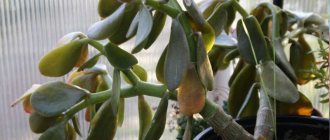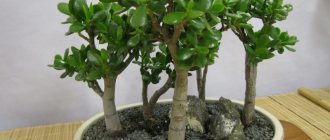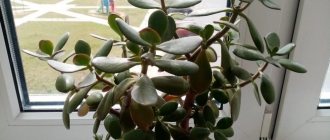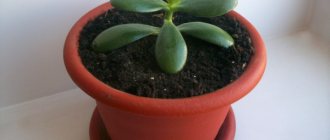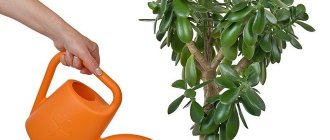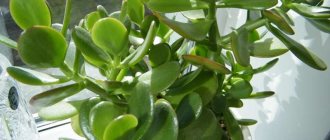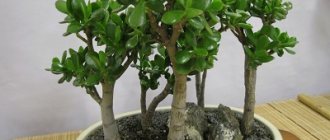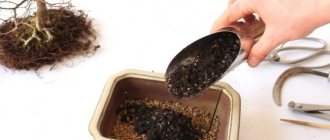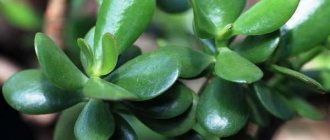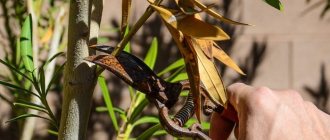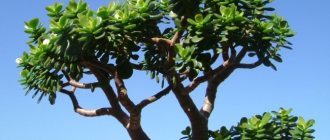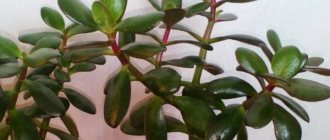Why does the fat woman need a thick trunk?
At home, Crassula can reach one and a half meters in height.
At the same time, it forms an extensive crown, but an extremely small root. This disproportion is due to cultural origin - in the arid regions of Africa, plants store water in the trunk and leaves, and the root only performs the function of pumping water to the vegetative organs. Adult crassulas have slender trunks that cannot support a huge crown, and the tree often falls along with the pots or pulls its roots out of the ground. The diameter of the stem does not allow moisture and plastic matter to be pumped to the top of a large plant quickly enough to provide it with everything it needs.
What other nuances are there:
- a money tree with a thin trunk and thin curved branches does not look the most attractive;
- the leaves, not receiving enough nutrients, fall off prematurely, exposing young shoots.
It is unlikely that a large plant can be grown without a thick central stem - the trunk simply will not support the weight of the crown.
How to properly pinch a fat plant?
Pinching is something that can replace pruning a money tree. This is an operation to remove the kidneys at the point of their growth. Subsequently, instead of the removed buds, 2 young shoots usually grow, which begin to branch densely.
This is a less traumatic operation for branches than pruning, and therefore more gentle.
Pinching can be done using different methods:
- Use tweezers or nail scissors - it is important not to damage adjacent leaves.
- Using your fingers, you should twist the kidney, not tear it off.
Pinching is carried out at the moment when the shoot reaches the length required by the owner (this is important, since the overgrown shoot can only be trimmed). Therefore, if necessary, pinching can be done at any time of the year, except for the winter dormancy period, when the fat plant does not grow.
What does the diameter of the stem depend on and what does it affect?
A strong foundation is equal not only to the aesthetic appearance of the tree, but also to the normalized flow of sap inside the plant. This is responsible for the movement of essential nutrients. The thicker the trunk, the more useful elements reach the leaves.
The branches and leaves of the Crassula are heavy and delicate, and if the tree is thin, it can break under their weight.
In general, there are three main factors influencing stem diameter:
- Pot size. Being in the wrong container can encourage weakening of the root system, making it difficult for the tree to grow wider.
- Lighting. The same thing is observed when keeping the plant in low light conditions.
- The presence or absence of low-lying branches. If they are cut off completely, the plant will do everything possible and spend all its strength to thicken the trunk and expand the crown.
Crassula is a light-loving plant, and this fact must be taken into account when choosing a place for it indoors.
Forming a thick trunk using the distillation method
There are a couple of special techniques to make the central branch of the crassula thicker. They are used to stretch the trunk, or to create bonsai from money trees.
Crassula must begin to form in the initial stages of growth so that the main shoot is really strong and thick. This will require less effort than correcting a large, mature money tree.
Substrate and dishes
When planting Crassula in a narrow pot, you should not expect a thick trunk. With good care, regular pruning and pinching, it will grow, but extremely slowly.
Professional gardeners prefer not only to have drainage holes at the bottom of the pot, but also to have a layer of drainage (for example, gravel) under the soil layer. Such actions will prevent water stagnation, ensure good ventilation and the absence of root rot.
Barrel expansion
We must also not forget about proper overclocking. The gradual formation of a thick stem consists of the following steps:
- After about 10 leaves come out, pinch the crown. Due to this, the plant will produce side shoots. The bottom plates should not be removed to expose the stem, they add the required thickness and should fall off naturally with age.
- On the upper branches that form the crown, remove growing points on a regular basis, even during dormant periods. But under no circumstances touch the lower ones.
- As the Crassula grows, the branches at the base lengthen; shorten them by a third. The appearance of tops on a trunk that has begun to harden thickens it, but slows down the development of the crown.
- After a couple of years, when the main stem is strong enough, cut off all the lower branches and tear out the leaves and tops.
If you want to get a money tree with a stem diameter of 10–15 cm, you will need to be patient, since the process is not quick. Thicker lower branches must be trimmed from time to time, leaving 2-3 cm columns that will dry out and fall off on their own. At first, unsightly “scars” are visible, but soon they will heal and will be almost invisible.
How to trim correctly?
Any gardener can carry out the pruning process independently at home. For convenience, adult plants need to be examined from all angles to see where branches and leaves need to be removed. Transplantation is not carried out at such moments, that is, the pot cannot be changed.
When pruning, a milky-white liquid is released - there is no need to be afraid of this, the juice simply forms a protective film on the wound.
Step-by-step process for pruning Crassula:
- Prepare your tools. Secateurs or special scissors are ideal for this procedure, but they should not be used on plants that have previously been diseased or infested with pests. It is best to disinfect the instrument with alcohol.
- Find 2 branches that form a V from the trunk. Place your finger on them: this will be the place where you need to trim.
- Trim the trunk 1-3 cm above the V-shaped branches. Hold the scissors at an angle of 45°, the cut should be clean, without unnecessary branches and leaves.
- Remove branches from the top and sides of the tree.
- Trim branches with dry or brown leaves.
- Trim the tree to half size. Do not prune too much at one time, otherwise the plant may become diseased and stop growing.
You can learn more about pruning from this video:
Young plant
The younger the money tree, the easier and faster it is to prune. Typically, a young Crassula is a rooted and growing cutting that has no side shoots. If you don't prune it, it will grow high up and without branches. Pruning a fat plant at home will make it look like a tree.
Trimming the cutting depends on how tall it is:
- The cutting is more than 20 cm. It is necessary to trim so that the remaining stump is 15–20 cm high, cut 1 cm above a pair of leaves. Some time after the procedure, side shoots will begin to grow from the axils of the upper leaves.
- A stalk whose length is from 15 to 20 cm. It should not be cut, but pinched. To do this, remove the highest growing point on the cutting.
If the young Crassula has already grown up and has several side shoots, its crown can be significantly increased. To do this, pinch the upper shoots, after which the crown begins to branch densely.
Mature plant
For pruning a large and mature money tree, a comprehensive method is most suitable. The specimen already has many branches, some of them will be shortened when pruned, but the rest will continue to grow. Here you will need corrective pinching of the crown.
It is advisable to combine formative pruning of mature money trees with sanitary pruning.
Step-by-step instructions for trimming an adult Crassula:
- Trim dry, old, dying branches.
- Completely remove all shoots growing inside the crown, as well as long thin branches.
- Cut off all very long shoots that stick out from the crown. Long shoots are shortened by 1/4, perhaps even by half, so that new shoots form from the cut site.
- Remove hanging and downward branches completely. During the growing season, pinch out large branches.
You can learn more from the video:
At least two shoots should appear from a distant growth point (usually 2-3 pieces). If only one sprout is “born” at the pinching site, it must be removed again so that new shoots grow in this place and the tree begins to branch more richly.
Tree with a thick trunk
If you need to process an already mature plant with a strong thick trunk, it will be more difficult to work with it than with young fat plants. It will be necessary to cut:
- long branches - the optimal length is selected based on their wishes and the location of the tree;
- hanging extra shoots;
- shoots growing inside;
- diseased and dry branches;
- branches growing parallel to each other, the strongest and healthiest ones should be left.
To ensure that no visible stumps remain, you will need to cut along the “ring”:
Creating a beautiful and fluffy crown
To create a fluffy crown on an already mature plant with long branches, it is necessary to cut off excess shoots.
The cut should be at a height of 2–3 mm above the last pair of leaves, so as not to leave an unsightly stump. Try to make the cut even and straight: plant elements that are concave or cut with a blunt instrument may rot.
It is best to do pruning in stages: this allows you to accurately match the desired crown shape. The tree will also have the opportunity to rest between injuries.
To reduce crown thickening, it is advisable to remove the inner leaves. But be careful - branches with all the leaves removed may dry out.
Crassula on a trunk
To install the standard form, you need to cut off the top and leave shoots only in its upper part.
As branching progresses, all lower shoots are removed, creating a bare trunk. The top part is cut off and the buds are pinched to form a round crown. The tree-like standard form of Crassula has a thick bare trunk 15–25 cm high, depending on the size of the plant. The crown can be round or slender, green and lush.
For transplant
It is necessary to prune indoor plants, including Crassula, after a period of dormancy or flowering. The same applies to transplantation. But these traumatic procedures cannot be combined. An interval of at least 30 days is required between manipulations.
The best time for both procedures:
- early spring, precisely March;
- Sick plants need to be pruned urgently; at such moments, the time of year does not matter.
Decoration
The Japanese have learned to grow miniature trees from almost any type of plant; this art is called Bonsai. It is also possible to grow a money tree in this style. The tree grows quickly enough to soon form a dense crown, a thick trunk, similar to a towering tree.
Certain types of Crassula are best suited for Bonsai:
- Tree-like.
- Ovata and its variety "Tricolor".
- The Hobbit.
These species are fast growing. As soon as the Bonsai cuttings take root, they are planted in flat containers designed specifically for growing such trees. Drainage is required at the bottom of the container. The plant is grown in soil of the following composition:
- turf soil - 3 parts;
- leaf soil - 1 part;
- sand or other baking powder - 1 part.
More information about shaping a tree in the traditional Japanese style:
Is it possible to make the main stem thicker if the tree is already mature?
Succulents easily survive any changes in themselves. The younger the tree, the easier it is to change its structure. Trees that are more than 8–10 years old can also be stimulated, but this requires more patience from the grower. It will not be possible to grow the plant to 15 cm, but you can make it thicker in two ways.
Drastic pruning
Nobody needs an ugly crown, so don’t feel sorry for it. The florist must select the desired height of the stem by cutting off the top part. If there are thick branches below, they should be left, and if they are too long, shortened by a third. New shoots and leaves on the trunk are not touched.
If the whole process is carried out in the spring, many tops will soon appear. With late pruning, Crassula can “return to life” only at the beginning of the growing season, but is able to immediately produce young shoots.
The upper branches form the crown - they are regularly pinched, branches that thicken and spoil the appearance are removed. The lower ones are protected - they are responsible for increasing the thickness of the trunk, and are shortened only when they become too long.
Kerbovka
If the owner of the plant manages to create a beautiful crown, and the stem remains thin, you can do without large-scale pruning. You need to do the following:
- There are dormant buds on the trunk - they look like small nodules. Cut off small sections of rectangular or crescent-shaped bark from the top.
- Lubricate the wounds with cytokinin paste.
- Soon tops will emerge from the buds.
- Next, accelerate the trunk, just as with radical pruning.
Some gardeners manage to achieve the effect without the use of stimulants, simply by slightly damaging the bark above the dormant buds. But this is not always possible; the described method is more reliable.
It is better to carry out kerbovka in the spring - during the period of active sap flow.
Strengthening
The best period for thickening the stem is dormancy; for succulents this is winter.
If the tree is tall but has a long trunk and no low branches, stimulation is necessary. To do this, make a slight injury by scraping the bark in two or three places on the tree’s wing. After a few weeks, a new bud will form in this place. You can strengthen a tree trunk like this:
- Trim off a third of the lower branches.
- Remove half of the longest top straps on the tree.
- Treat the cuts with crushed coal or ash.
These manipulations will help develop more roots, thereby improving the appearance of the tree and resulting in a thicker stem.
Reproduction of adenium by cuttings and layering
You can get new plants from an adult bush or tree in several ways:
- seeds - at the end of winter or beginning of spring, seeds are sown in moist soil, lightly sprinkled with earth, be sure to use bottom heating and cover the container with seedlings with film. After germination, when the plant produces 3-4 strong leaves, it can be transplanted into a separate cup, and then into a pot;
- cuttings - adenium cuttings rot quickly, so it is not the easiest way to propagate the plant. Cut stems 10-12 cm long are deepened into the substrate, slightly moistened and placed in a warm place;
- layering - in May or June, you can make a circular cut on an adult and strong stem, treat the cut site with a root formation stimulator, wrap it in sphagnum and secure it with polyethylene. After a few weeks, the cuttings begin to develop roots, then they are planted in a pot, separated from the main bush.
What care contributes to the formation of a thick trunk?
It is not necessary to use special tree maintenance techniques to increase the diameter of the central stem. It will grow without them, but rather slowly - it will take several years for the trunk to become thick enough. But proper and timely care will help with overclocking.
Care Tips:
- It is necessary to grow a money tree in the sun. Some owners do not know why the plant's leaves have red edges, believing that the plant is diseased. And this, on the contrary, means that the flower receives enough light to form thick branches and short internodes.
- It is necessary to water the plant moderately. But regularly.
- At rest, normal room temperature is required. Reduced to 10-14°C.
- Top dressing - fertilizer for cacti. Once every 2 weeks, exclusively in spring and summer.
- Planting and transplanting. In a large ceramic pot, with a clean mineral substrate, without peat or soil.
Aftercare recommendations
The main goal of care is to maintain a given shape. After pruning, Crassula will be most comfortable in partial shade. Reducing the amount of light can help the injury heal faster. In bright light, trees may begin to shed their leaves.
Lighting mode
After completing the circumcision procedure, the fat woman must be moved for some time to a darker place compared to its usual place of stay. But as soon as the crown of the tree begins to slope down and the leaves become soft, the plant must be moved to its original place (in the light without direct sunlight).
Watering
Crassula collects water in its leaves to survive short-term droughts, and can survive for quite a long time without watering. But there is no need to abandon the plant - the soil should not dry out and turn into stone.
For the fat plant, overwatering is the most dangerous - the plant can begin to rot, including the roots and leaves with stems.
What watering schedule to follow:
- in summer, in very hot weather, plants need to be watered moderately, several times a week;
- In winter, watering once a week is sufficient.
Be sure to spray the tree, so the leaves are saturated with moisture and cleaned of dust.
Feeding
It is necessary to fertilize the plant about twice a month, but only in the summer, more precisely from May to September. The best plant food is cactus fertilizer. Liquid fertilizing is preferable, from complex fertilizers.
Transfer
Transplantation is carried out annually in the spring, a month after pruning. The best option is to prune the plant in March and leave the replanting until April.
Crassula does not need too spacious pots, since undeveloped soil will turn sour and the roots will begin to rot. You should choose a pot with a low side, 1 cm wider than the previous container. Drainage holes covered with shards are required.
